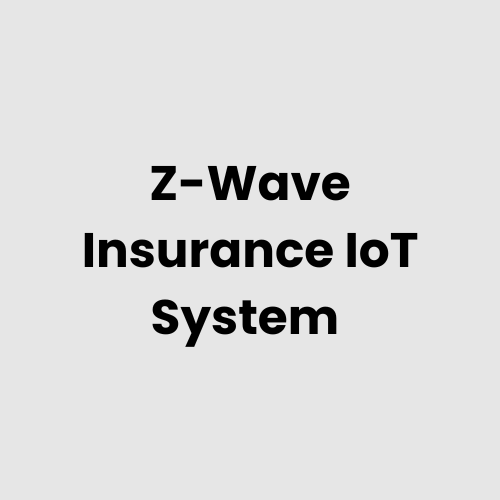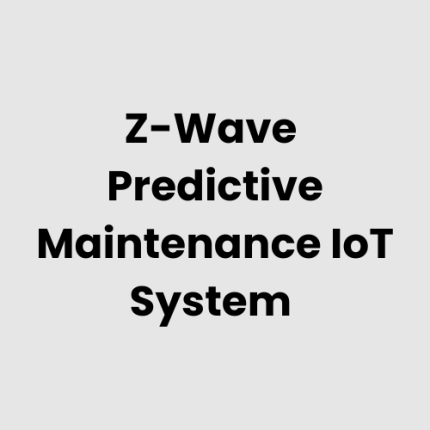Description
Technical Architecture of Z-Wave Enabled Insurance IoT System
The Z-Wave Enabled Insurance IoT System integrates low-power Z-Wave communication protocols with a layered IoT framework, comprising edge devices, gateways, and a centralized control server. Devices such as sensors and smart plugs relay data to Z-Wave hubs, which aggregate and send information to cloud or on-premises servers. Advanced analytics engines and AI modules then process the data, offering predictive insights and real-time monitoring.
List of Hardware for Z-Wave Enabled Insurance IoT System
- Z-Wave Sensors: Smoke, water leak, temperature, motion, and door/window sensors.
- Smart Hubs: Z-Wave-compatible controllers for data aggregation.
- Actuators: Devices for automated response systems, such as shut-off valves and alarms.
- Smart Plugs and Outlets: For monitoring and controlling electrical appliances.
- Cameras: Z-Wave-enabled security cameras for visual monitoring.
- Gateways: Devices to ensure connectivity between Z-Wave networks and external systems.
- Backup Power Supplies: Uninterruptible power sources for critical devices.
Physical Placement Considerations of the Hardware
- Sensors: Strategically placed at high-risk zones such as kitchens, basements, or near windows to monitor potential hazards like fire, water leaks, or unauthorized entry.
- Smart Hubs: Centrally located within properties to maximize Z-Wave signal coverage.
- Cameras: Installed at entry points or critical locations for comprehensive surveillance.
- Actuators: Positioned near devices they control, such as main water lines or electrical panels.
Hardware Architecture of Z-Wave Enabled Insurance IoT System
The hardware architecture is a multi-layered system comprising:
- End Devices Layer: Includes all sensors, cameras, and actuators.
- Network Layer: Z-Wave mesh network enabling communication between devices and gateways.
- Control Layer: Centralized hubs or controllers for data processing and routing.
- Cloud/Server Layer: Remote servers or local installations for data storage, analytics, and user interface.
Deployment Considerations of Z-Wave Enabled Insurance IoT System
- Network Design: Optimizing Z-Wave mesh to ensure robust connectivity across devices.
- Scalability: Modular design for adding or upgrading devices as needs evolve.
- Data Security: Employing end-to-end encryption and regular firmware updates to mitigate risks.
- Regulatory Compliance: Ensuring adherence to local and international IoT standards.
- User Training: Offering training for system use and maintenance.
Relevant Industry Standards and Regulations
- ISO/IEC 27001
- GDPR (General Data Protection Regulation)
- NIST Cybersecurity Framework
- FCC Part 15
- UL 634 Certification
Local Server Version for Running Z-Wave Enabled Insurance IoT System
The local server version integrates with Z-Wave hubs to provide on-premises data processing and control. This ensures uninterrupted operation even without internet access. GAO Tek offers tailored local server solutions with robust hardware and software configurations to meet specific customer needs.
Cloud Integration and Data Management
Z-Wave-enabled devices transmit data to cloud platforms for storage and advanced analytics. GAO Tek’s cloud integration solutions provide secure access to dashboards, predictive analytics, and AI-driven risk assessments. The system is compatible with leading cloud platforms, ensuring flexibility and seamless integration with existing insurance management software.
GAO Tek Inc., headquartered in New York City and Toronto, empowers insurers with Z-Wave-enabled IoT systems that enhance risk assessment and operational efficiency.
GAO Case Studies
USA
- New York City, New York
In New York, a major insurance firm implemented a Z-Wave-enabled system in commercial properties to monitor environmental hazards such as flooding and fire. Sensors detected changes in humidity, temperature, and air quality, allowing insurers to reduce risk and respond faster to claims, ensuring better protection for their clients. - Los Angeles, California
A property insurance company based in Los Angeles adopted Z-Wave technology for real-time monitoring of residential properties. The system helped in detecting water leaks and fire risks early, minimizing potential damages and improving overall claim management efficiency. - Chicago, Illinois
In Chicago, a regional insurer integrated Z-Wave-enabled sensors to monitor industrial facilities for fire and carbon monoxide leaks. This IoT system allowed for quicker intervention, lowering claims and enhancing the safety of workers in high-risk environments. - Houston, Texas
In Houston, Z-Wave-enabled smart sensors were deployed in flood-prone areas to monitor water levels in real-time. This proactive approach helped the insurance company assess flood risks more accurately, improving underwriting processes and enabling more precise risk mitigation strategies. - Miami, Florida
Insurance providers in Miami implemented Z-Wave sensors to track temperature fluctuations and humidity levels in homes, protecting policyholders from potential mold or water damage. The system also sent real-time alerts, enabling timely intervention and reducing overall claim costs. - San Francisco, California
San Francisco-based insurers incorporated Z-Wave technology to monitor earthquake and structural integrity in buildings. The sensors detected slight shifts in the foundation, alerting insurers to potential risks and reducing exposure to large-scale property damage claims. - Dallas, Texas
A Texas-based insurer utilized Z-Wave devices to enhance the risk assessment of home and auto insurance policies. By collecting data on local weather conditions, such as wind speeds and temperatures, insurers could offer more personalized coverage and minimize claim payouts related to natural disasters. - Atlanta, Georgia
In Atlanta, Z-Wave sensors were used in commercial buildings to track indoor air quality and detect fire hazards. The system enabled the insurance provider to monitor high-risk areas and offer customized insurance products, improving overall safety and lowering claims. - Washington, D.C.
A government contractor in Washington, D.C. used Z-Wave technology to monitor electrical systems for faults and fires. Real-time data allowed for immediate response, enhancing both operational efficiency and safety, and improving risk management for both residential and commercial policies. - Seattle, Washington
In Seattle, an insurance company used Z-Wave-enabled weather sensors to monitor the impact of frequent rainstorms on properties. The data from these sensors helped adjust premiums in real-time and offered customers immediate alerts to prepare for inclement weather. - Philadelphia, Pennsylvania
Philadelphia-based insurers implemented Z-Wave systems to manage property insurance risks by using IoT sensors to monitor potential fire hazards and gas leaks. With instant alerts and automation, insurers were able to assess risk and respond effectively, reducing claims. - Denver, Colorado
Insurance companies in Denver deployed Z-Wave devices to assess the risk of snow and ice accumulation on commercial roofs. The system collected data on snow load, temperature, and structural strain, enabling insurers to better understand weather-related risks and avoid costly claims. - Phoenix, Arizona
In Phoenix, Z-Wave technology was used to monitor air conditioning systems in homes and commercial buildings. The system detected failures in HVAC units, allowing insurers to offer preventative maintenance and protect policyholders from equipment-related claims. - Boston, Massachusetts
Insurance providers in Boston utilized Z-Wave-enabled systems to track water usage and detect leaks in older buildings. This early detection system led to fewer claims related to water damage and helped insurers offer more affordable policies to property owners. - Minneapolis, Minnesota
In Minneapolis, Z-Wave-enabled devices were used in commercial properties to monitor heating systems and detect issues before they led to pipe bursts or other temperature-related damage. This proactive approach helped insurers mitigate the impact of winter weather on claims.
Canada
- Toronto, Ontario
Toronto insurers deployed Z-Wave sensors to track changes in temperature and humidity across residential properties, particularly in older homes at risk for mold and water damage. The data-driven approach improved underwriting and offered customers more affordable premiums based on accurate risk profiles. - Vancouver, British Columbia
In Vancouver, a leading insurer integrated Z-Wave technology to monitor air quality and fire risks in multi-family dwellings. Real-time data helped insurers make quicker, more informed decisions, reducing response time to claims related to fire and smoke damage and improving customer satisfaction.
GAO Tek Inc., headquartered in New York City and Toronto, is committed to advancing the insurance industry through cutting-edge Z-Wave-enabled IoT systems that improve risk management, claim accuracy, and customer satisfaction. Our solutions are designed to help insurance providers gain deeper insights into environmental factors, enabling them to offer personalized coverage and reduce operational risks. With over four decades of experience, GAO Tek delivers top-tier R&D, quality assurance, and expert support for seamless implementation across the U.S. and Canada.
Navigation Menu for Z-Wave
- Z- Wave Gateways/Hubs
- Z-Wave End Devices
- Z-Wave-Cloud, Server, PC& Mobile System
- Z-Wave Accessories
- Z-Wave Resources
Navigation Menu for IoT
- LORAWAN
- ZIGBEE
- Wi-Fi HaLow
- Z-WAVE
- BLE & RFID
- NB-IOT
- CELLULAR IOT
- GPS IOT
- IOT SENSORS
- EDGE COMPUTING
- IOT SYSTEMS
Our products are in stock and can be shipped anywhere in the continental U.S. or Canada from our local warehouse. For any further information, please fill out this form or email us.
We are actively looking for partners who are like us located in the U.S. and Canada. For more information on partnering with GAO, please visit Partner with GAO Tek Inc. It lists various ways to partner with GAO, such as OEM Partnerships, Technology Integration, Distribution and Reselling Opportunities, Presenting at the Leading Event Tek Summit, Joint R&D Projects, Training and Consulting Services, Industry-Specific Collaborations, Research and Academic Partnerships.



